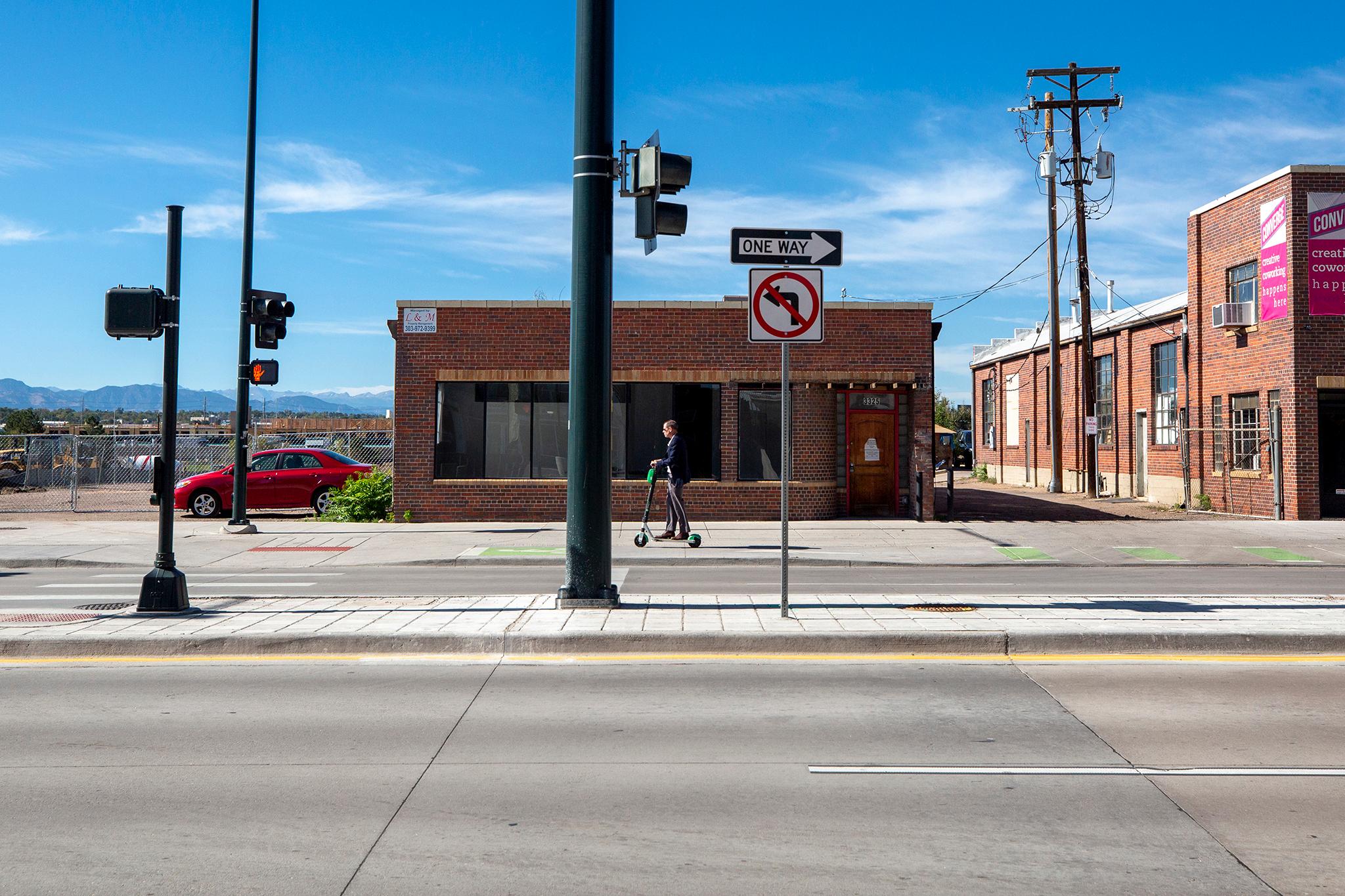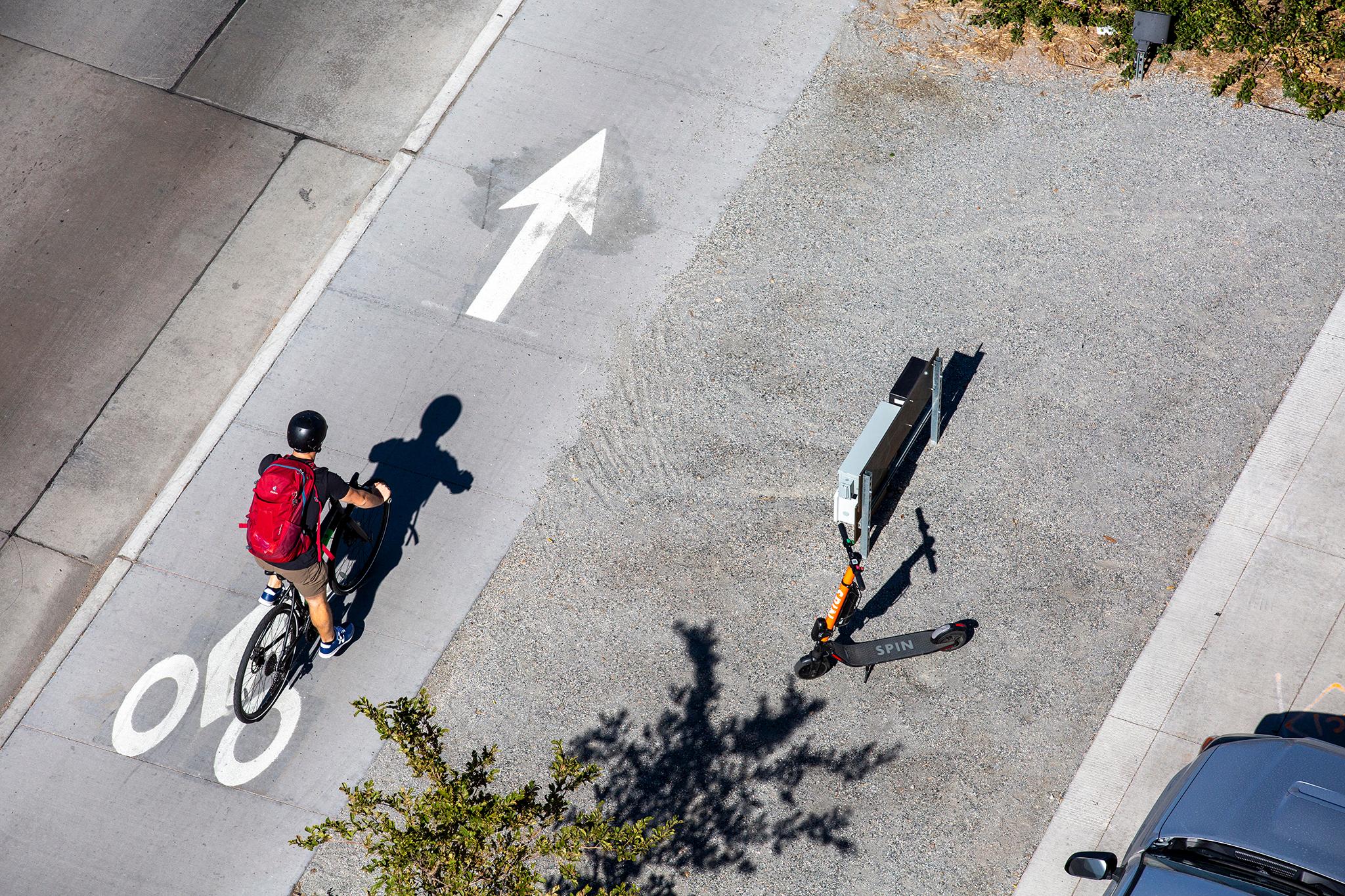The way John Hayden talks about Brighton Boulevard demonstrates a way of thinking about streets that is slowly becoming the prevailing paradigm in Denver, at least among the people who shape and build them.
Reality has a long way to go before matching intentions, but the paradigm goes like this: Roads are for moving cars and trucks through the city. But streets are for moving people. Streets are where people and destinations mesh to form a place, with activity and identity and interesting things to see and do.
That's why Hayden, an activist who chairs the Mayor's Pedestrian Advisory Committee, talks about Brighton in terms usually reserved for houses rather than highways.
"Look at those street walls, those great walls along the street," Hayden said standing at the corner of 31st Street, pointing at the continual blocks of apartment buildings and businesses across the street. "Those walls are the kind of thing that makes you feel like you're in a city."
Development on Brighton has created places for people to go. But it's the new, modern street infrastructure between 29th and 44th streets that makes those places reachable by modes other than driving. Prior to the massive, $32.1 million reconstruction of the street that finished last year, you'd be lucky to find a sidewalk on the thoroughfare, let alone 2.6 miles of walkways and bikeways.
In a perfect example of cause and effect, the city built sidewalks and bike lanes, and people now use sidewalks and bike lanes.
Denver Public Works never counted how many people walked and biked along the corridor before it had basic human infrastructure. And the streets department doesn't plan on documenting those numbers post-construction.
But Denverite did some tallying. During a recent Monday afternoon, the intersection of 31st and Brighton saw 85 people on foot and in wheelchairs from 3 to 4:30 p.m.
For reference: That's nearly double the 46 pedestrians counted, on average, in a (more scientific) study done by WalkDenver at the corner of West Colfax Avenue and Irving Street in 2017. But the Brighton count is tiny in comparison to the nearly 3,000 people who typically walk on just one block of the 16th Street Mall during that time period.

The number of people who biked, rode electric scooters and skateboarded down Brighton that afternoon totaled 48 in an hour and a half. The number of people driving? Unclear. But it was way, way higher.
"We're just incredibly pleased that (the infrastructure) has attracted folks and that it's supporting the neighbors there," said Karen Good, a city planner with Public Works who has worked on the project since its inception.
Brighton used to have almost no sidewalks, so some Denverites are also thrilled they can finally walk on Brighton physically separated from traffic. Jay Misany has used the new street twice this summer, he told Denverite, once to walk from the Denver Coliseum to 35th Avenue and once after a show at Mission Ballroom.
Simply walking on Brighton is still somewhat of a novelty for some. Others, including people catching the bus, did it for years under much worse conditions -- some gravel here, some crumbling concrete there.
"During my first walk this year down Brighton Boulevard me and my buddy realized we were walking in the same place as five years prior when I first visited Denver while still going to college," Misany said. "Thankfully, after that warehouse party, we were able to grab a taxi from a nearby gas station and get back to our hotel."
Now pedestrians and bicyclists have separated, raised lanes, for which there have been positive if mixed reviews.
"I like them. It's nice to be on a cycle track and not down with the cars," said Rob Toftness, a local bike advocate. "I wish they were a little better illuminated because there are a few spots that are dangerous in the dark, particularly the curb cuts. If you don't see the curb at night you're going over your bars."
And yet Denver's biggest, newest "complete street" -- a term for streets that cater to walking, biking, transit and driving -- has earned criticism.
Portions of the sidewalk remain too narrow to walk three abreast or pass others comfortably, as evidenced by my recent stroll down the street with Hayden and Jill Locantore, executive director of WalkDenver.
Beyond comfort, there's the matter of civil rights. Before he was a Denver City Council member, Chris Hinds rolled the corridor in his wheelchair with his friend Jamie Perkins of street light fight fame. She wrote a column about the experience last year.
"Some sidewalks were so cramped, Chris's wheelchair barely fit," Perkins wrote in the piece for Streetsblog. "And several sections did not seem to comply with the sidewalk widths mandated in the Americans with Disabilities Act."
That federally mandated width is 5 feet. Every piece of the new Brighton Boulevard sidewalk meets ADA standards, according to Good from Public Works, even though she admitted to "pinch points" where the city opted to include more things -- trees, benches, planters, plus the sidewalk and bike lane.
"There are some spots where everything's got to be closer to its minimum than we would prefer on any kind of major new investments, but that's what you get when you're working in a real live corridor with real live buildings and people," Good said. "There's some give and take there."
The brick buildings that give the street a historic feel sometimes come right up to the sidewalk, squashing the walkway up against the bike path. If and when those places are redeveloped, the city will require the developer to provide a significant chunk of public right-of-way, Good said.

But Locantore says the city prioritized cars in its design, which pushed people walking and biking to the margins. She helped guide the government-led design process as a member of the "stakeholder committee."
"You still have the vast majority of the public right-of-way dedicated to cars, and that was just presented to us as non-negotiable," Locantore said. "And so you end up with what you always do: Somebody has to sacrifice on the margins and often it's the pedestrian that ends up getting sacrificed."
Locantore pointed to other examples: Some blocks don't have signalized crosswalks for pedestrians -- though the city did add new ones to 29th and 35th streets. The sidewalk bleeds into street-front parking lots at several locations with no clear delineation. Wide, sweeping corners let drivers take turns at high speeds. Ninety-degree corners would force drivers to slow down, she argued, but city planners said they had to account for large trucks that use the boulevard, which still caters to industrial uses.
Still, the city's premier pedestrian advocacy group says the new Brighton Boulevard is eons better than the last iteration and sees it as a model for other scary arterial streets.
Denver's deadliest streets are usually its widest -- Federal Boulevard, Hampden Avenue, Colorado Boulevard -- because those roads let drivers go faster, and speed is the top factor in pedestrian and bicyclist deaths.
From 2016 through 2018, drivers have killed one bicyclist and seriously injured three people -- one cyclist and two motorcyclists -- on this section of Brighton, according to city data. No one's been hurt since reconstruction.
WalkDenver's Locantore is hoping the city copies and pastes the street design onto Federal Boulevard to make it more walkable, more bikeable and less deadly.
"This is a whole new standard of what's possible on arterial streets," Locantore said. "And so why could this not be the design for other arterials? It's definitely upping the bar for arterials even though it still is not ideal."
"And I think that's the key to remember," said Hayden, "is that this is an arterial that basically serves the same purpose that Federal Boulevard serves in terms of moving a high volume of people."












